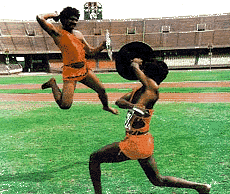| Cheibi Gad-Ga | |
| Kalari Payattu | |
| Silambam | |
| Thang-ta | |
| Thoda | |
| Kalari Payattu
A Kalari Payattu demonstration includes physical exercises and mock duels - armed and unarmed combat. It is not accompanied by any music or drumming, but is a silent combat, where style matters the most. Kalari Payattu is practiced by women also. Unniyarcha was a legendary heroine, who won many battles with distinction. Today, Kalari Payattu is a method of physical fitness, and an empty-handed means of self-defence. Yet, it is tied to traditional ceremonies and rituals. Kalari Payattu consists of various techniques and stages. Among them are:. Uzhichil Uzhichil, or the massage with the Gingli oil, is used for imparting suppleness to the body, but only persons with a thorough knowledge of the nervous system, and the human body, conduct the 'uzhichil'. Maipayattu Body exercises or Maippayattu includes the twists and turns of the body, leaps and jumps, and poses, designed to gain control over various parts of the human body. Sticks of Kolthari This is the next stage where training in handling various staves of wood or canes of different lengths are imparted. The long stick is kettukari and the short one, kuruvadi. Otta - a Weapon for the 'coup de grace' The otta is an 'S' shaped staff, with a knob at one end, made of the toughest portions of the tamarind tree.These sticks, which are about 2 feet long, are specially suitable for attacks on the nervous system. Metal weapons or Anga Thari Weapons of various metals are used in training and combat sessions, like the sword, sword and shield, two types of knives, daggers, the spear and the 'urumi'. Various exercises are performed with these weapons. Puliyankam (Sword Fight) Wielding the sword in an efficient manner, is considered to be the peak of perfection in Kalari Payattu. Various methods in the use of the sword, as a weapon of offence and defence, are being practiced today, but the most awe-inspiring of these, is the Puliyankam, where the combatants fight like tigers, propelled by powerful fuels - extraordinary elan and agility. The Spear Vs the Sword In this combat, one contestant is armed with a sword and shield, and the other with a spear. Due to the length of the spear, the swordsman faces a disadvantage, but if he knows how to exploit all the weak points of the spear-man, and take advantage of all the opportunities, that come his way to get under his opponent's guard, he can easily triumph over his opponent. Barehanded Fight or Verumkai In unguarded moments, there are some special ways of getting out of a tight situation, by using one's hands or a piece of cloth or a rope. Locks and blows are in vogue. Attacks on the nervous system by the edge of one's palm, are enough to paralyse the opponent. Various types of blows with different effects are, therefore, practiced to perfection. Character, fitness and sheer courage - these are the demands of Kalari Payattu, which has about it a distinct spiritual and mythical aura. To succeed in this martial art, one needs plenty of fire in the belly, energy, drive and fierce commitment. |
 Kalari
is the Malayalam (language spoken in Kerala) word, for a special kind of
gymnasium, where the martial art known as Kalari Payattu, is practiced.
It had its origins in the 4th century A. D. Legends claim, that the art
began with the sage Parasurama, who possessed mystical powers. He built
temples and also introduced martial arts, which have influenced and
shaped many other arts. The art reached its zenith in the 16th century,
in the days of Thacholi Othenan - a celebrated chieftain of north
Malabar.
Kalari
is the Malayalam (language spoken in Kerala) word, for a special kind of
gymnasium, where the martial art known as Kalari Payattu, is practiced.
It had its origins in the 4th century A. D. Legends claim, that the art
began with the sage Parasurama, who possessed mystical powers. He built
temples and also introduced martial arts, which have influenced and
shaped many other arts. The art reached its zenith in the 16th century,
in the days of Thacholi Othenan - a celebrated chieftain of north
Malabar.